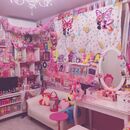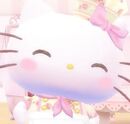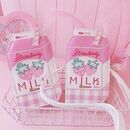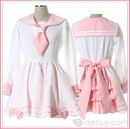Tag: Source edit |
m (→Web Pages) Tag: Source edit |
||
| Line 25: | Line 25: | ||
*[http://www.san-x.jp/ San-X net] |
*[http://www.san-x.jp/ San-X net] |
||
*[https://www.tokidoki.it/ tokidoki] |
*[https://www.tokidoki.it/ tokidoki] |
||
| − | + | Note: the pages below are in Japanese |
|
*[https://www.sanrio.co.jp/ サンリオ: ホーム] |
*[https://www.sanrio.co.jp/ サンリオ: ホーム] |
||
*[http://ribonetta.blog133.fc2.com/blog-entry-446.html いつも一緒 ] |
*[http://ribonetta.blog133.fc2.com/blog-entry-446.html いつも一緒 ] |
||
Revision as of 13:55, 10 April 2021
Kawaii (かわいい) is a Japanese term and aesthetic referring to the unique concept affirming childish and young things. However, different from the English word "cute", it is peculiar in that it's so diversified that it spawned many subgenres which often are far removed from the original concept. For example, Gurokawa refers to grotesque cute things and Erokawa to everything cute erotic that appeals to male sexual desire.
Kawaii mostly has to do with childish or cute things, often if not always in a pastel color scheme. The Sanrio company is a prime example of this aesthetic, with their adorable characters and pastel color palettes.
History
In ancient Japanese, the words “kawayushi” (かはゆし) and “kaohayushi” (かほはゆし) were used. Different to the nowadays kawaii, they were associated with a negative image, referring to something "so pitiable one can't stand it". During the Heian Period (794 – 1185), they evolved into “utsukushi” (うつくし), which already had a meaning similar to nowadays kawaii, being used to describe anything "adorable". This usage first appeared in Japan's oldest tale "The Tale of the Bamboo Cutter" (Taketori Monogatari), and was referring to Princess Kaguya. It could be said that she was the very first character representing kawaii culture. Later on, the word further evolved into utsukushii (美しい), which means "beautiful" in English, and it had become a word that was mainly used to praise objects in the real world instead of referring to something "cute". At the same time, that now abadoned meaning of "cute" attached itself to “kaohayushi” and “kawayushi”, removing the negative image and slowly turning positive. This change became noticable in writtings of the Muromachi Period (1336 – 1573) were a paradigm shift occurred where things previously viewed in a negative light was seen in reverse. From there on, those words shortened to "kawaii" and started to take on a positive strength, instead of being seen as a weakness.
In 1973, a company called the Yamanashi Silk Center renamed itself to Sanrio, and its characters "Hello Kitty" and "My Melody" exploded in popularity, causing the "Sanrio Miracle" (サンリオの奇跡). Around the same time, Sony Creative Products and Gakken began expanding their business with "kawaii" character goods. The Rika-chan doll began to exceed the sales of the more well-known Barbie line around 1970, and it became a time in which products sold more based on the symbolic value of cuteness, rather than their usefulness. Beyond that, "non-standard girlish script" (変体少女文字) was introduced as the typeface in 1974, and this overly cute writing style became so popular among high school girls, teachers started to have issues reading their homework. Another change of that time was among girl's manga magazines. Previously, they mostly came with posters and stickers of popular boy groups, similar to western girl's magazines, but in 1975 this changed to "kawaii" stationary goods with characters from the mangas printed on them.
In 1982, the magazine "Olive" (オリーブ) was launched by Heibon Publishing (now Magazine House) and gave birth to the first wave of "kawaii revolution" (かわいい革命) as well as "otome" culture. It originally was launched as a special edition of the boy's fashion magazine "Popeye" (ポパイ) with the tagline “Magazine for City Girls”, and it mainly featured casual street fashion. One year later, it relaunched with a complete overhaul, started to focus on girly romanticism, and changed its tagline to “Magazine for Romantic Girls”. The fans of the magazine dolled themself up in ribbons and frills, lace, floral prints, and other girlish styles. Popular with those girls that idolized its style were brands that gave off a fairytale-like feel, such as Pink House by designer Isao Kaneko. They would collect things that appealed to their sense of cuteness and mix them, expressing their individuality, and this is would evolve into what is referred to as Harajuku or kawaii fashion nowadays.
Web Pages
Note: the pages below are in Japanese
webshops
- Blippo Kawaii Shop
- Juwas
- Lazcat warning: the page is in spanish
- Kawaii Pen Shop
- Tofu Cute
- Jellybeet shop
- Kawaii therapy
- Kawaii Shop Japan
- Kawaii Gifts
- Claw Grabby Store
- nothing basic here
- Kawaii Berry Shop
- Cutie Pie Kawaii
- Nippon Kawaii
- Kawaii Panda
- A cute shop
- Sugar Bunny Shop
- ROSY'S GARDEN
Music
Spotify Playlists
- 💖🌸Kawaii Music🌸💖 Spotify playlist by Ana Manzanares
- Kawaii / Aesthetic / Cute Spotify playlist by Annygirly
- Kawaii Future Bass Spotify playlist by kyra.adiavira
- Kawaii Anime Music | Cute Loli Vibes Spotify playlist by Selphy
- Lost Umbrella 💙✨ Hyper Kawaii🎵 Weeb TikTok Jpop Anime Japanese 💟 Vocaloid Koi no uta Omae Wa Mou Spotify playlist by van
- Kawaii Gaming Music Spotify playlist by omgitssegalega
- Kawaii Music Spotify playlist by Ryuu
- cutecore vibing Spotify playlist by ナンあこ
- kawaii/cutecore songa playlist by usagipinkberry














